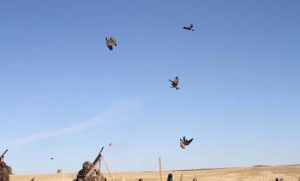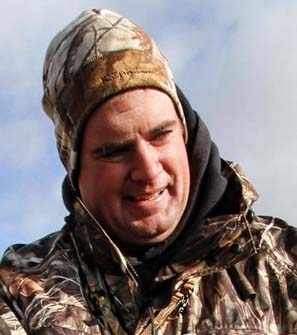The early Canada goose seasons that are now available to hunters across the Country creates some tremendous opportunities for waterfowl hunters. A number of states, which now have nuisance seasons or early resident goose hunting opportunities, stretch from the Midwest to the East Coast. Most of these additional and liberal hunting seasons revolve around the abundance of Giant Canada Geese that typically weigh between ten to twelve pounds.
 These resident populations of birds that have populated much of the northern tier of the Nation west of the Rocky Mountains are the largest subspecies of Canada Geese. Through massive reintroduction efforts, these birds have been remarkable in their ability to expand and adapt. A bird that was once threatened is now flourishing on golf courses and corporate ponds far from the prairies of the Midwest Interior that these birds originated.
These resident populations of birds that have populated much of the northern tier of the Nation west of the Rocky Mountains are the largest subspecies of Canada Geese. Through massive reintroduction efforts, these birds have been remarkable in their ability to expand and adapt. A bird that was once threatened is now flourishing on golf courses and corporate ponds far from the prairies of the Midwest Interior that these birds originated.
Most of the early Canada Goose seasons fall as early as August with some occurring in September and these seasons are designed to increase the harvest of these resident birds without compromising the management of some other subspecies of Canada Geese that traditionally migrate through the United States during the traditional fall season. Because these seasons do occur early, hunters have to adjust their strategy.
Any hunter who has spent time pursuing Canada geese during the early season has witnessed the frustration of family flocks of birds landing short of the Decoy spread. Early season sees family flocks of geese still in a tight knit family structure where they may feed or loaf around other families of geese but each family of birds seems to need a certain amount of space.
Over the years, I have learned to just avoid these small flocks and focus on the larger flocks of last years juveniles that did not breed. These one year to two year old birds often gather to form sometimes large flocks of fifty to a hundred birds or more depending on the number of geese in an area and these birds are much more sociable and cooperative during the early season.
Early season geese are typically pretty naïve to hunting tactics. You can often do a lot of things wrong or not have many decoys or be a very accomplished caller and kill a surprising number of geese but everything does boil down to location.
Scouting is always important for waterfowl hunting but maybe even more so during these early seasons. Scouting not only tells you where these birds are going in the mornings and evenings to eat but also what the flock dynamics are. During many early seasons, a majority of crops will still be unharvested so activity is often exaggerated on the few crops that are harvested. In some areas, barley gets combined earlier than most other crops so much of the early activity will focus on one particular crop.
Other regions see a lot of activity around feed lots or pastures. Once you locate where these birds are moving to feed, the next step is to recognize what you are dealing with regarding the social structure of the flock. Large flocks of the juvenile birds as discussed earlier are ideal but these flocks of juveniles birds often mingle and feed with the family flocks which consist of a few adults leading a harem of young.
With the early Canada goose season, hunters typically enjoy more success if they can space the decoys out in small family flocks and leave ample space between the flocks. When dealing with just the tight nit family groups, space the decoys out even more so and really exaggerate the amount of open space between decoys and make the pocket large if you plan on laying in the decoys or use ground blinds in the spread.
The flocks of juvenile birds often just coast right into the decoys and often back pedal or finish close to the decoys but expect the family flocks of birds to want to stop short. During the early season, we often position our blinds much closer to the edge of the most down wind decoys and cheat right on the edge of the spread to get better shots at birds that approach the decoys low and want to land short.
If downwind cover like a fence row or drainage is available, hunters can often be very successful by hiding in the cover down wind of the decoy spread. When using cover downwind of the decoy spread in this situation, adapt the spread by eliminating the open space so they are more likely to line up over your location. Use fewer decoys (less than three dozen) and don’t spread the decoys very wide apart or give the birds as many options for landing so that the birds are more likely to float over your location or circle the decoys a few times offering shots. When using cover, keep the calling to a minimum or don’t call at all if you are positioned fifty to a hundred yards down from the spread and just rely on your scouting to bring the birds in.
Typically if you have scouted a good area and are set up in a field that the birds are using, they are going to come and give you a look regardless of calling or flagging. This is probably the biggest difference between hunting the early season and the traditional fall season with migrating birds. With new migrating birds in the area, you can run traffic and use good calling, flagging and large spreads to pull birds in and hunters are typically dealing with larger numbers of birds.
During the early season, if you are not set up in the field the birds are using, it can become much harder to decoy geese. The hunter is typically dealing with smaller numbers of birds during the early season and these birds know the terrain and know where they are heading each morning. But with that being said, these birds have not been pressured yet and will typically drop down on a few dozen decoys without any calling or flagging. Focus on where you set up versus how you set up.
One other wrinkle that can cause frustration for early season goose hunters is when geese movements get inconsistent. If the geese keep hitting the same pasture or fresh combined cereal crop for days on end during both the evening and morning, there is not much that can go wrong. What is nice about smaller flocks of big geese is that it takes them a while to feed out a field compared to a massive swarm of snow geese. Sometimes, however, geese will feed at one location in the morning and move to a different location to feed in the evening or switch fields daily.
This is a tough situation I want to avoid as it becomes a guessing game to where they will be next. The tactic that I am going to explain next might not work for everybody but since I have a lot of places I can hunt and typically look over multiple flocks of birds before I decide where I will set up. What I will often do if possible is drive close enough to the birds where I bump them into the air with my vehicle just by slowly driving as close as I can on an established trail or road. If the geese immediately go back down into the same field and don’t stray far, I know those birds like that particular field and don’t want to leave it. If the birds keep flying and head over to a field a mile away and just seem random in where they go, I let those birds sit longer until they get a taste for something they really like.
The early Canada goose seasons have been a double edge sword in that these birds now see decoy spreads and get hunted for much longer periods of time so I do believe that the early season opportunities can make decoying birds more difficult during the traditional waterfowl season frameworks which occur in the fall. By the time the traditional waterfowl season opens, these birds have already been exposed to a few weeks of gunfire.
The opportunities to watch decoying geese during the early season however have been great for getting more people interested in goose hunting and provide additional opportunities to get outside. If you don’t have a massive decoy spread or not confident with your calling abilities, now is the time that you can experience great waterfowl hunting providing you spend the time to scout. You can create great memories with less than three dozen decoys. Good quality decoys that have a very realistic profile and look, like the Dakota Decoys Extreme Honkers are ideal. Mosquitoes can be an issue during the early seasons so bring a Thermocell or bug repellent. Early season goose hunting can provide great sights of low, decoying birds with typically close in your face shots and liberal bag limits. Combine comfortable, warm weather and great decoying for an early jump start on the waterfowl season.

The author, Jason Mitchell spent several years guiding waterfowl in central North Dakota before hosting the television show, Jason Mitchell Outdoors.

